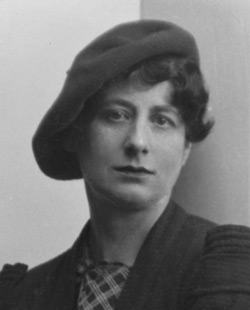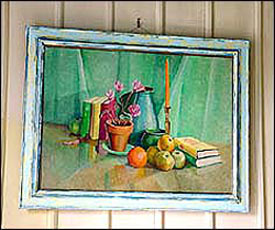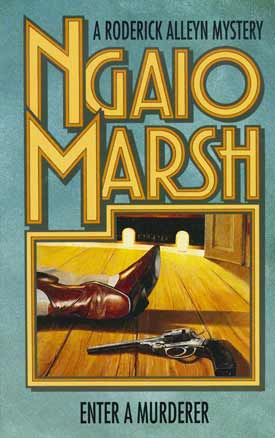 In 1888, Henry Marsh, the oldest son of a large English family, immigrated to New Zealand, where he met New Zealand-born Rose Elizabeth Seager. Her father was a prominent public official. After they married, Edith Ngaio Marsh was born in the late 1890s in Christchurch, the largest city on the South Island. She was an only child and was always referred to by her middle name Ngaio which is pronounced NYE-oh and is a Maori word meaning “reflections on the water.”
In 1888, Henry Marsh, the oldest son of a large English family, immigrated to New Zealand, where he met New Zealand-born Rose Elizabeth Seager. Her father was a prominent public official. After they married, Edith Ngaio Marsh was born in the late 1890s in Christchurch, the largest city on the South Island. She was an only child and was always referred to by her middle name Ngaio which is pronounced NYE-oh and is a Maori word meaning “reflections on the water.”
Marsh was an only child and appeared to have a happy childhood, although her relationship with her father was more fun-filled and lively than with her mother. However, her mother’s family was always interested in acting and the theater, an interest that Ngaio picked up at an early age and kept throughout her life.
Life in New Zealand was not nearly as rigid as it might have been in post Victorian England. Ngaio Marsh wrote in her childhood diary:
…you must try to understand the life of a girl who lives on the free hills goes without stockings in summer and runs about all day.
She attended St. Margaret’s College, an expensive high school known and was heard to speculate years later that the tuition must have been a true burden for her parents. The First World War had a profound effect on New Zealand with so many young men deployed to battle. Ngaio was very close to a young man named Ned Bristed who died in Flanders. Before he went overseas, he gave Ngaio a ring which she kept for the rest of her life.

The life changing event for Ngaio Marsh came in 1928 when she was invited to visit old friends from New Zealand who had re-settled in England. She stayed for a number of years and in late 1931 decided to write a detective novel. She had the idea of writing a novel about a murder during the house party game of “Murders.” The idea had been used before but Marsh either wasn’t aware of that, or thought she could write a better novel using the game as a plot device. She finished the novel, A Man Lay Dead, and sent it to literary agent Edmund Cork who represented Agatha Christie. Shortly after sending the manuscript, Ngaio received a cable from her father asking her to come back to New Zealand because her mother was sick. Within months her mother died and Ngaio decided to stay in New Zealand with her father. Edmund Cork sent word that A Man Lay Dead would be published in 1934, and Ngaio was happy to learn that the publisher wanted more books. And that is when the world met, for the first time, Chief Inspector Detective Roderick Alleyn of Scotland Yard, who is assigned to solve the murder. Over the next half century Marsh would write more than thirty novels and numerous short stories featuring the aristocratic Alleyn. In her second novel, Enter A Murderer, she incorporated her love of theater into her detective fiction.

Marsh’s books were so popular that she was considered one of the four “Queens of Crime.” Along with Agatha Christie, Margery Allingham and Dorothy L. Sayers, she dominated British mystery fiction for decades. In 1966 she was named Dame Commander of the British Empire. (D.B.E.)
She often traveled between England and New Zealand where she continued to support local theater and the careers of many young actor and actresses. She also produced a number of plays.
Her final book, Light Thickens was published in 1982. It was once again, a mystery involving a theater company production of Macbeth. A few weeks after being notified that the novel was accepted by her publisher, Marsh died at home in New Zealand.
Ngaio Marsh clearly elevated the police procedural to a well appreciated type of crime novel. She also moved her story lines away from puzzles and more toward psychology and character development, traits that are exceedingly popular today.
Twice short-listed for Best American Mystery Stories, Terrie Farley Moran’s cozy mystery novel, Well Read, Then Dead will be released by Berkley Prime Crime in August, 2014. She blogs amid the grand banter of the Women of Mystery.

I’ve often wondered how to promounce this author’s name, who’s work I have loved. Thanks to you, now I know. What a wonderful post. I love learning about the Hall of Famers.
I know, pronouncing Ngaio has always been a challange. I agree the best thing about the Hall of Fame posts is that there is always a nuance, a quirk, a lifestyle issue that never came to the reader’s attention and suddenly–there it is!
Back in the 70s, when it was still relatively safe to hitchhike in most parts of the US as long as you stayed off the interstates, I once caught a ride from my hometown to a nearby college town where I was getting my 2nd degree with a gentleman who was in the area visiting relatives. He was from New Zealand, and asked me how much I knew about the country. I told him that I knew that Ngaio Marsh was from there, to which he replied, “That’s more than most Americans know about New Zealand!” We had a nice chat, and he went out of his way a bit to get me to campus safely. A very nice gentleman!
I very much enjoyed learning more about Ngaio Marsh, Terrie. There was a period when I read an extensive amount of her work. And, still, if I’m in a used book store and see a Marsh hardback I have to snap it up.
Yes, I think she was a real leader in her time and offered wonderful reading material to generations.